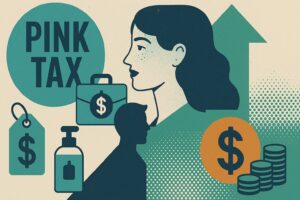Reading time: 5 minutes
Published: August 10, 2025
Modified: August 23, 2025
Have you ever noticed how the same razor or shampoo can cost more when marketed to women? This blog reveals the truth about the pink tax: why it exists, how it impacts your finances, and what you can do to challenge it. This price discrepancy is a subtle yet significant financial burden that many women face.
But it doesn’t stop there. When you consider that men, on average, earn more than women, the disparity becomes even more glaring. Let’s dive into the world of the pink tax, explore its implications, and uncover what you can do to combat it.

Key Takeaways
- The pink tax ↗ refers to the higher prices women pay for similar products compared to men.
- On average, men earn more than women, exacerbating the financial impact of the pink tax.
- Consumers can take action by becoming more aware of these price differences and advocating for change.
Understanding the Pink Tax
At its core, the pink tax is a form of gender-based pricing discrimination. It affects a range of products, from personal care items to clothing and even toys. The name “pink tax” comes from the fact that products marketed to women are often pink or pastel in color.
But the issue goes far beyond aesthetics. The pink tax is a systemic problem that reflects broader societal inequalities. If you’ve ever wondered why your favorite women’s shampoo costs a little more than a men’s shampoo, you’re not alone.
Why Women Pay More
Several factors contribute to the pink tax. Companies often justify higher prices with claims of additional product features or ingredients. However, studies have shown that these differences are minimal, if they exist at all. For example, the California Attorney General’s office ↗ highlights that products marketed to women can cost significantly more than comparable men’s products.
Even if a women’s product contains different, more expensive ingredients than a similar men’s product, which might seem to justify a higher price, it’s worth asking why those ingredients differ in the first place. And if the extra ingredients are truly necessary, are manufacturers simply passing along the additional cost, or are they adding a premium on top?
The Earnings Gap Compounds the Issue
As if paying more for products wasn’t enough, women also face a gender pay gap. On average, women earn less than men for doing the same work. This earnings gap means that women have less disposable income, making the impact of the pink tax even more pronounced. It’s a double whammy that can make managing finances and saving for the future more challenging for women.
How to Combat the Pink Tax
So, what can you do about it? First, awareness is key. By recognizing the pink tax, you can make more informed purchasing decisions. Look for gender-neutral or men’s products that offer the same quality at a lower price.
Additionally, consider speaking out and advocating for change. Whether it’s through social media, contacting companies directly, or supporting legislation that addresses gender-based pricing discrimination, every effort counts.
Legislative Efforts and Consumer Rights
Many states have begun to address the pink tax through legislation. For instance, California has laws prohibiting gender-based pricing discrimination. However, enforcement can be challenging, and not all states have similar laws.
Understanding your consumer rights and supporting policy changes can help drive progress. Feel empowered to demand fair pricing and hold companies accountable.
The Broader Implications
The pink tax is not just about higher prices; it’s a reflection of systemic gender inequality. Addressing it requires a multifaceted approach that includes consumer awareness, legislative action, and corporate responsibility. By tackling the pink tax, we can work toward a more equitable society where everyone pays a fair price, regardless of gender.
For more insights on related financial issues, explore our article on the impact of new tariffs and how they might be affecting your wallet.
A Counter-argument to the Pink Tax
A July 2023 study ↗ argues that much of the so-called “pink tax” stems from product differences, not deliberate overcharging. Yet many of us have seen nearly identical items priced differently simply because they were marketed to women, and those differences often feel arbitrary.
So while the study is worth citing as a counter-argument, it doesn’t erase the real-world sense that women, as consumers, end up paying more.
Conclusion
The pink tax is a persistent issue that affects women’s finances in subtle yet significant ways. While it may seem like a small price difference here or there, it adds up over time and compounds the challenges women face due to the gender pay gap.
By becoming aware of the pink tax and advocating for change, you can help pave the way for a more equitable future. Remember, every small action contributes to a larger movement toward fairness and equality.
Have you experienced the pink tax firsthand? Share your examples in the comments to help raise awareness and inspire change.
Very interesting article. Sometimes I wish I was 40yrs younger to use my voice. I always go to my gender products. I’ll definitely be more conscientious. Thank you. So much injustice. Sickens me.